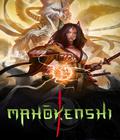It can be a bit difficult for deck-building games to stand out. The deck-builder genre has become increasingly filled with more distinct and unusual takes. There's the iconic Slay the Spire, multi-level tower defenses like Monster Train, team-based combat like Midnight Suns, and countless more. That is part of what makes Mahokenshi interesting. It adopts a familiar formula but throws in enough wrinkles that it can easily stand on its own merits. Rather than limit you to a single combat arena, Mahokenshi makes the entire land your battlefield.
Mahokenshi can best be described as a mix of a Slay the Spire-style deck builder and a tactical game. At its baseline, it follows the same basic formula of most deck builders: You build a deck of cards and have a limited amount of energy to play those cards in each round. Most of the familiar attack/block/status elements are there.
You have four different clans to choose from: Jade, Ruby, Sapphire and Topaz, each with its own distinct play style. For example, Ruby is built around heavy offense and can even gain the ability to fly, which nullifies terrain issues and allows you to strike in ways that other clans can't. Sapphire is extremely tanky and durable, and can often perform attack and defense in a single action. As is the standard for the genre, you'll also unlock new cards and items as you increasingly play as a specific clan.
What changes Mahokenshi is that you're not fighting on a generic battlefield. Instead, the entire game is set on a large hex map. Your energy isn't only spent on attacking, but it's also necessary for moving around the map. Enemies also move on the map and have their own patrol patterns and attack ranges. This adds a genuine layer of strategy-RPG to the deck-builder formula. If you're fighting a lone goblin, it isn't a big deal, but if you have to deal with an oncoming horde of multiple enemies, then it would be very easy to get overwhelmed. On the other hand, you can use this to your advantage by leading enemies to choke points or advantageous terrains.
Terrain is a major factor in the gameplay. It impacts the defensive viability of a hex, the movement cost, and even which cards you can use to their full effectiveness. For example, fighting in a forest will give you a passive defensive buff no matter what, so if you can lure enemies to fight you on open plains while you're in a forest, you'll already have a combat advantage. Some cards allow you to travel more easily over certain kinds of terrain, which means you can potentially escape from deadly foes instead of fighting them. Different cards and characters have different advantages in terrain as well. For example, one card allows you to draw two cards for 1 energy cost. If you use it while in a forest, it becomes free instead. (When upgraded, it actually gives you energy.) When building your deck, you need to consider the terrain of the map you're fighting on.
Each mission is its own distinct map, and you begin with a fresh deck every time. Your goal is to build a strong enough deck to take on some of the game's challenges by exploring the land. The map is dotted with various places of importance. A lot of these are stand-ins for the usual kind of upgrade zones that are seen in deck builders. Castles contain talismans, which are the game's version of relics, or special items that provide passive benefits. You can find card packs to build your deck, upgrade or destroy your cards, and so on. You need to plot out the best way to go about getting to these things because enemies continue to spawn and chase you down, and if you waste too much time powering up, you might find yourself slowly chipped down by repeated attacks.
In addition, each mission also has optional objectives to complete, such as defeating powerful optional foes or finishing certain objectives quickly. If you complete the bonus challenges, then you unlock special crystals that you can invest in various meta-progression trees. These trees offer all kinds of small but cool benefits, ranging from starting with upgraded cards to making services cheaper. They can be re-specced at any time, but it's clear that you'll need to make sure to do as many quests as possible to give yourself an advantage over increasingly powerful foes.
We only played a couple of missions of Mahokenshi for our preview, but we were fairly impressed with the interesting and distinctive take on the genre. The same basic deck-builder gameplay takes on an entirely different feel when you mix it with elements of a strategy-RPG. Having to think about which cards work best for your build, environment and enemies can alter your combat approach. I'm genuinely curious to see how the later missions play out; I won't have to wait long, since Mahokenshi comes later this month (Jan. 24, 2023) on the PC.
More articles about Mahokenshi











 Mahokenshi is a unique blend of adventure, deck-building and deep hex-grid strategy.
Mahokenshi is a unique blend of adventure, deck-building and deep hex-grid strategy.







